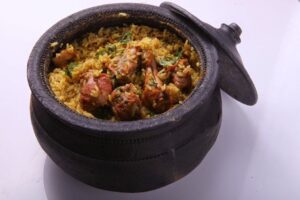
What’s the name of the dish which you can always connect to? A dish which brings back memories, tastes like heaven and is something you can eat any day.
For me, it’s Biryani. Any special occasion at our home, and Biryani will gracefully mark its presence. Over the years, I have tried different varieties of this delight, each of them made patiently with spices, marinade and most importantly love.
One of the varieties of Biryani, known far and wide is the Hyderabadi Biryani. The special element here is that raw rice and raw meat are cooked together, unlike the usual way of cooking both the items separately. Hyderabadi Biryani has been passed down from the bygone era and has remained true to it’s past. It carries forward it’s authenticity with pride and celebrates itself by bringing joy to whoever tastes it.
The story of the origin of Hyderabadi Biryani goes back to the rule of the Mughal emperor Aurangzeb. It was then that Nizam-Ul- Mulk was appointed as the new emperor of Hyderabad. What’s intriguing here is that the Nizam’s kitchen became a place of food experiments. Here, his chefs created a diverse range of food with fish, shrimp, quail, deer and even hare meat.
There are several interesting stories connected with the origins of ‘Biryani’. The belief goes that this dish originated in Persia and was brought to India by the Mughals. However in present day Iran, Biryani is a dish which doesn’t have rice! It’s rather meat wrapped up in rumali roti (paper thin bread).
A legend connected to Biryani is that Mumtaz Mahal (Shah Jahan’s wife) visited the army barracks once. She saw that the soldiers present were starving. The chefs were asked to prepare a dish with meat and rice for the soldiers. They added spices and saffron to the dish, and cooked it over fire. This resulted in the famous cuisine – Biryani.
Another narrative of the past gives credit to the Arab traders who regularly visited the Malabar coast of India. It is believed that they brought the biryani to India. There are records of a rice dish which goes by the name Oon Soru in Tamil literature. Made of rice, ghee, meat, turmeric, coriander, pepper, and bay leaf, it was served to the military warriors.

Our magical Hyderabadi biryani is cooked in a ‘Handi’ or an earthen pot. The method used to prepare biryani in Hyderabad is ‘dum’. Dum means to properly seal the pan using dough, this helps to retain the steam inside. The raw meat and raw rice are cooked together, in addition spices and water are added to it. It’s important to note that spices are of immense importance to the Biryani. The flavours of cardamom, cinnamon, black peppercorns, cloves along with the saffron strands brings to the Biryani lavishness reflecting on the Nawab’s legacy in Hyderabad.
Anuradha Reddy, the convenor of Intach Hyderabad has said that just like the Hyderabadi society, which is a confluence of different cultures, Hyderabadi biryani has become famous because of its ability to imbibe many food ingredients. In fact, the practice of using dry fruits is an Iranian trait.
An interesting fact about the Hyderabadi biryani is that it is served with two traditional items at its side, Mirchi ka Salan and Raita. Mirchi ka Salan is made out of chilli and peanuts. Whereas coriander and onion are added to Raita or dahi. Everytime you order biryani in Hyderabad, these delights will make sure to join you along.
There are many places to relish this dish. Hotel Shadab, Paradise, Cafe Bahar, ITC Kohenur are a few of the famous places offering this mouthwatering biryani. These places in Hyderabad are truly of historical importance and are a must-visit. If you visit Hyderabad the next time, make sure to order for yourself this delight! It’s not a dish, it’s an emotion!